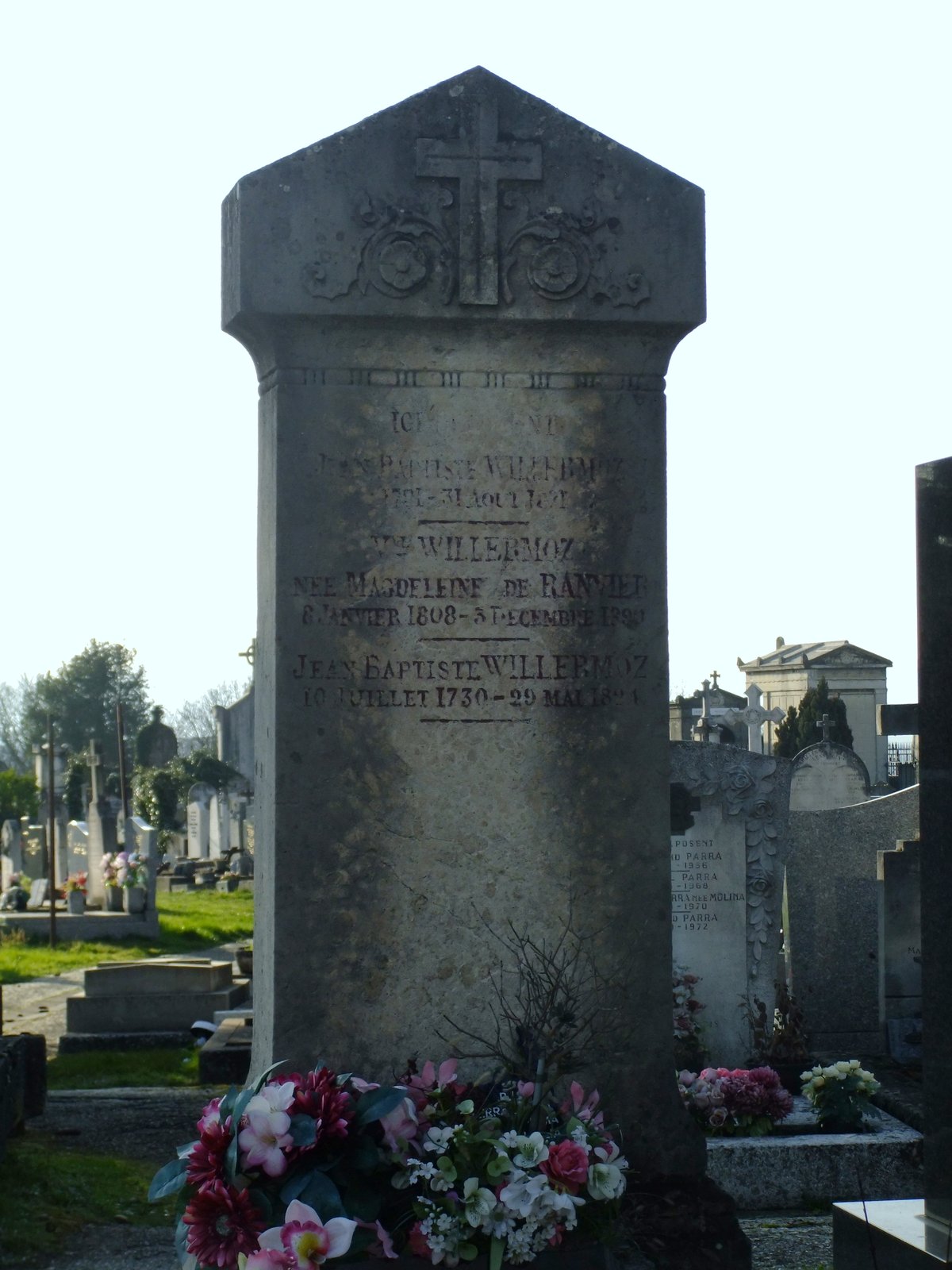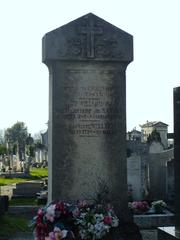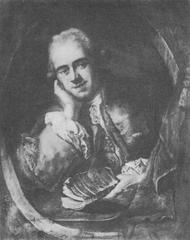
Jean-Baptiste Willermoz in Lyon, France: Visiting Hours, Tickets, and Historical Sites
Date: 14/06/2025
Introduction: Jean-Baptiste Willermoz and His Significance in Lyon
Jean-Baptiste Willermoz (1730–1824) holds a distinguished place in Lyon’s history as a silk merchant, influential Freemason, and spiritual reformer. His pivotal role in shaping the Rectified Scottish Rite placed Lyon at the heart of Enlightenment spirituality and esoteric traditions. Willermoz’s life and work, intersecting commerce, philosophy, and charity, continue to draw scholars and culturally curious travelers to Lyon, where his influence is woven into the city’s streets, archives, and museums.
Visitors can explore Willermoz’s legacy by visiting key sites such as his tomb at the Cimetière de Loyasse, the Renaissance-era streets of Vieux Lyon, and museums that capture the vibrant artistic and intellectual backdrop of his era. For practical information—including visiting hours, ticketing, accessibility, and guided tours—reliable resources such as the Lyon Tourist Office and the Lonely Planet Lyon Guide are recommended. (Le Progrès, OpenEdition Books, Nos-Colonnes)
Table of Contents
- Introduction
- Life and Historical Context of Jean-Baptiste Willermoz
- Key Willermoz-Related Sites in Lyon
- Practical Visitor Information
- Frequently Asked Questions
- Conclusion and Visitor Recommendations
- References and Further Reading
Life and Historical Context of Jean-Baptiste Willermoz
Jean-Baptiste Willermoz was born in Lyon in 1730 to a prosperous bourgeois family. Initiated into Freemasonry at 19, he quickly distinguished himself for his dedication and organizational skill, founding the “La Parfaite Amitié” lodge by age 23 (Le Progrès).
A turning point came in 1767 when Willermoz met Martines de Pasqually, founder of the Order of the Élus Coëns. Willermoz became Pasqually’s principal delegate for Lyon, and their extensive correspondence—now held in Lyon’s municipal library—remains a vital resource for scholars (OpenEdition Books). Following Pasqually’s death, Willermoz was instrumental in reworking and preserving the order’s teachings, leading to the creation of the Rectified Scottish Rite, which integrated mystical and chivalric ideals into Freemasonry.
Willermoz’s influence extended beyond spiritual matters. He was a key administrator at the Hospice of Lyon, where he applied Enlightenment values of charity and civic engagement, and he navigated the city’s turbulent revolutionary period with resilience.
Key Willermoz-Related Sites in Lyon
Cimetière de Loyasse: Willermoz’s Tomb
- Address: 46 rue du Cardinal Gerlier, 69005 Lyon 5ème
- Visiting Hours: Daily, 8:00–17:00 (until 17:30 from May 2 to Nov 2). Closed May 1 and July 14.
- Admission: Free
- Accessibility: Accessible by public transport; mostly paved paths, though some areas may be uneven.
Established in 1812, Cimetière de Loyasse is Lyon’s first modern cemetery and the final resting place of Jean-Baptiste Willermoz. The cemetery’s tranquil grounds invite reflection on Lyon’s spiritual traditions. Notable figures such as Édouard Herriot and Pauline Jaricot are also buried here.
Vieux Lyon: The Renaissance District
- Highlights: Wander cobblestone streets lined with Renaissance façades and discover the atmosphere of Willermoz’s era.
- Traboules: These secret passageways, used by silk merchants and Masonic societies, are open to visitors (many are accessible during the day; some require guided tours).
- Saint-Jean Cathedral: A centerpiece of the district, reflecting the historical context of Willermoz’s time.
Presqu’île and Lyon’s Masonic Heritage
- Location: Between the Rhône and Saône rivers; includes Place Bellecour and historic commercial streets.
- Significance: The area was a hub for silk merchants and Masonic activity in the 18th century. While original lodge buildings are not open to the public, the district’s architecture and atmosphere provide a sense of Willermoz’s world.
Museums and Cultural Institutions
- Musée des Beaux-Arts de Lyon: 20 Place des Terreaux, 69001 Lyon. Tues–Sun, 10:00–18:00; closed Monday. Tickets: €8, free for under 26s.
- Musée de l’Imprimerie: 13 Rue de la Poulaillerie, 69002 Lyon. Tues–Sat, 10:00–18:00; Sun, 11:00–18:00. Tickets: €6.
- Musée Gadagne: Focused on Lyon’s history. Tues–Sun, 10:00–18:00; closed Monday. Tickets: ~€8.
- Lugdunum Museum: Roman history and context for Enlightenment Lyon. Closed Tuesday; tickets €8–12.
These museums offer insight into the artistic, intellectual, and social climate of Willermoz’s lifetime.
Fourvière Hill and Basilica
- Access: Funicular from Vieux Lyon or on foot.
- Fourvière Basilica: Built after Willermoz’s era, it stands on a site of longstanding spiritual significance and offers panoramic city views.
- Nearby: Roman ruins and the entrance to Loyasse Cemetery.
Practical Visitor Information
Transportation
- Public Transport: Lyon’s TCL network (metro, tram, bus, funicular) connects all major sites. Single ticket: €2; Lyon City Card (from €29/day) includes unlimited travel and museum discounts.
- Funicular: Line F2 from Vieux Lyon to Fourvière Hill for Loyasse Cemetery and Basilica.
Accessibility
- Most museums and public sites are wheelchair accessible. Vieux Lyon and Fourvière have steep cobbled streets; comfortable shoes are advised.
Guided Tours
- Masonic Heritage Tours: Specialized tours cover Willermoz’s lodges and Lyon’s esoteric history. Prices: €10–€15. Book via the Lyon Tourist Office.
- Traboule Tours: Guided walks explore hidden passageways; booking recommended.
Best Times to Visit
- Spring (April–June) and Autumn (September–October): Pleasant weather, fewer crowds.
- Fête des Lumières (early December): A highlight for visitors, illuminating historic and Willermoz-related sites.
Suggested Itinerary
Morning: Walk Vieux Lyon, explore traboules, and visit Rue des Quatre-Chapeaux.
Midday: Lunch in a local bouchon.
Afternoon: Take the funicular to Fourvière, visit Cimetière de Loyasse and the Basilica.
Evening: Return to Presqu’île for dinner or a riverside stroll.
Frequently Asked Questions (FAQ)
Q: Is there a fee to visit Cimetière de Loyasse?
A: No, entry is free.
Q: Do I need tickets for museums?
A: Yes, major museums charge €6–€12. Many sites are included with the Lyon City Card.
Q: Are guided tours available for Willermoz-related sites?
A: Yes, several operators offer tours focusing on Lyon’s Masonic and esoteric history.
Q: Is Lyon accessible for people with reduced mobility?
A: Most main museums and public transport are accessible. Some historic areas have cobblestones and inclines.
Q: When is the best time to visit?
A: Spring and autumn are ideal for mild weather and fewer tourists.
Conclusion and Visitor Recommendations
Exploring Jean-Baptiste Willermoz’s Lyon connects visitors with a profound chapter of Enlightenment, esoteric thought, and civic responsibility. From the tranquil Cimetière de Loyasse to the bustling streets of Vieux Lyon and the insightful displays in the city’s museums, Willermoz’s spiritual and cultural legacy is accessible to all.
Plan your journey with practical information on hours, tickets, and transport. Enhance your experience with guided tours, the Lyon City Card, and digital tools like the Audiala app for interactive maps and audio guides. For further details, visit the Lyon Tourist Office or consult the Lonely Planet Lyon Guide.
Embrace the spirit of Willermoz—combine curiosity, respect for history, and openness to Lyon’s layered heritage for a memorable visit.
References and Further Reading
- Le Progrès article on Willermoz
- OpenEdition Books: Willermoz and Freemasonry
- Nos-Colonnes: Jean-Baptiste Willermoz, a Mystical Freemason
- Visiter Lyon
- Lonely Planet Lyon Guide
- This is Lyon: Historical Monuments
- TravelSetu Lyon Tourism
- Love to Visit France

































































